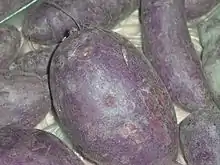Pigment violet de patate douce
Les pigments violets de patate douce sont des colorants alimentaires anthocyanique[1] - [2] - [3] - [4] extrait des tubercules de patate douce (Ipomoea batatas) à chair violette ou pourpre.

Les pigments violets de patate douce présentent un grand intérêt comme substituts des colorants chimiques, voire des colorants d'origine animale, comme le rouge cochenille, refusés par certains consommateurs. Ils possèdent une grande stabilité de couleur et ont une couleur plus intense et une gamme de coloris plus large, allant du rouge framboise au violet raisin, que les colorants extraits d'autres fruits et légumes. Ils sont également bien adaptés aux produits alimentaires car ils ont une saveur neutre, contrairement aux raisins par exemple, qui ont une belle couleur mais avec des tanins amers. En outre, les pigments de la patate douce présentent certains avantages pour la santé : ils sont légèrement anti-inflammatoires et anticancérigènes[3].
Ce colorant pourrait avoir des applications en tant qu' agent mutagène[5] - [6], antioxydant[7] - [8] et anti-inflammatoire[7] - [9] - [8] - [5]. Des études ont permis de prouver que ce colorant protège contre les lésions induites par le D-galactose[5] - [7] - [9] - [8] et qu'il a un potentiel en tant que traitement contre la galactosémie[10].
Composants chimiques
Les composants chimiques (de la classe des anthocyanidines) suivants ont été identifiés dans les pigments violets de patate douce[11] - [12]
- cyanidine 3-cafféoylsophoroside-5-glucoside[11]
- péonidine 3-cafféoylsophoroside-5-glucoside[11]
- cyanidine 3-cafféoyl-p-hydroxybenzoylsophoroside-5-glucoside[11]
- péonidine 3-cafféoyl-p-hydroxybenzoyl-sophoroside-5-glucoside[11]
- péonidine-cafféoyl-féruloylsophoroside-5-glucoside[11]
- cyanidine 3-caffeoylsophoroside-5-glucoside[11]
- cyanidine 3-(6′′,6′′′-dicafféoylsophoroside)-5-glucoside[11]
- cyanidine 3-(6′′-cafféoyl-6′′′-féruloylsophoroside)-5-glucoside[11]
- péonidine 3-O-(6-O-(E)-cafféoyl-2-O-beta-D-glucopyranosyl-beta-D-glucopyranoside)-5-O-beta-D-glucoside[12]
- cyanidine 3-O-(6-O-p-coumaroyl)-beta-D-glucopyranoside[12]
- péonidine 3-O-(2-O-(6-O-(E)-cafféoyl-beta-D-glucopyranosyl)-6-O-(E)-cafféoyl-beta-D-glucopyranoside)-5-O-beta-D-glucopyranoside[12]
- péonidine 3-O-(2-O-(6-O-(E)-féruloyl-beta-D-glucopyranosyl)-6-O-(E)-cafféoyl-beta-D-glucopyranoside)-5-O-beta-D-glucopyranoside[12]
Une étude japonaise de 1999 analysant la teneur en anthocyanes et la composition de 19 clones de patates douces à chair violette a permis d'identifier les facteurs génétiques responsables de la variation de couleur de la pâte de patate douce, allant du violet rougeâtre au violet bleuâtre. Sur la base du ratio péonidine/cyanidine, ces clones ont été classés en deux groupes : le type « cyanidine », chez lequel la couleur bleue prédomine, et le type « péonidine », dont la couleur vire vers le rouge avec l’augmentation du rapport péonidine/cyanidine. Ces résultats suggèrent qu'il est possible de prédire grossièrement le contenu et la composition en anthocyanes par l'analyse de la couleur de la pâte[13].
Notes et références
- (en) Cet article est partiellement ou en totalité issu de l’article de Wikipédia en anglais intitulé « Purple sweet potato color » (voir la liste des auteurs).
- (en) « Purple Sweet Potato », sur ddwcolor.
- (en) Eazyweb Internet Services, « Purple Sweet Potato Color », sur www.foodcolor.com.
- (en) « Purple Sweet Potato A Contender To Replace Artificial Food Dyes », NPR.org, (lire en ligne).
- (en) « Purple sweet potatoes among 'new naturals' for food and beverage colors », sur American Chemical Society.
- (en) Dong-mei Wu, Jun Lu, Yuan-lin Zheng, Zhong Zhou, Qun Shan et Dai-fu Ma, « Purple sweet potato color repairs d-galactose-induced spatial learning and memory impairment by regulating the expression of synaptic proteins », Neurobiology of Learning and Memory, vol. 90, no 1, , p. 19–27 (ISSN 1095-9564, DOI 10.1016/j.nlm.2008.01.010).
- (en) M. Yoshimoto, S. Okuno, M. Yoshinaga, O. Yamakawa, M. Yamaguchi et J. Yamada, « Antimutagenicity of sweetpotato (Ipomoea batatas) roots », Bioscience, Biotechnology, and Biochemistry, vol. 63, no 3, , p. 537–541 (ISSN 0916-8451, DOI 10.1271/bbb.63.537).
- (en) Qun Shan, Jun Lu, Yuanlin Zheng, Jing Li, Zhong Zhou, Bin Hu et Zifeng Zhang, « Purple sweet potato color ameliorates cognition deficits and attenuates oxidative damage and inflammation in aging mouse brain induced by d-galactose », Journal of Biomedicine & Biotechnology, vol. 2009, , p. 564737 (ISSN 1110-7251, DOI 10.1155/2009/564737).
- (en) Zi-Feng Zhang, Shao-Hua Fan, Yuan-Lin Zheng, Jun Lu, Dong-Mei Wu, Qun Shan et Bin Hu, « Purple sweet potato color attenuates oxidative stress and inflammatory response induced by d-galactose in mouse liver », Food and Chemical Toxicology, vol. 47, no 2, , p. 496–501 (ISSN 1873-6351, DOI 10.1016/j.fct.2008.12.005).
- (en) Jun Lu, Dong-mei Wu, Yuan-lin Zheng, Bin Hu et Zi-feng Zhang, « Purple sweet potato color alleviates D-galactose-induced brain aging in old mice by promoting survival of neurons via PI3K pathway and inhibiting cytochrome C-mediated apoptosis », Brain Pathology (Zurich, Switzerland), vol. 20, no 3, , p. 598–612 (ISSN 1750-3639, DOI 10.1111/j.1750-3639.2009.00339.x).
- (en) David J. Timson, « Purple sweet potato colour--a potential therapy for galactosemia? », International Journal of Food Sciences and Nutrition, vol. 65, no 4, , p. 391–393 (ISSN 1465-3478, DOI 10.3109/09637486.2013.860586).
- (en) Van-Den Truong, Nigel Deighton, Roger T. Thompson, Roger F. McFeeters, Lisa O. Dean, Kenneth V. Pecota et G. Craig Yencho, « Characterization of Anthocyanins and Anthocyanidins in Purple-Fleshed Sweetpotatoes by HPLC-DAD/ESI-MS/MS », Journal of Agricultural and Food Chemistry, vol. 58, no 1, , p. 404–410 (ISSN 0021-8561, DOI 10.1021/jf902799a).
- (en) Fan Qiu, Jianguang Luo, Shun Yao, Li Ma et Lingyi Kong, « Preparative isolation and purification of anthocyanins from purple sweet potato by high-speed counter-current chromatography », Journal of Separation Science, vol. 32, no 12, , p. 2146–2151 (ISSN 1615-9314, DOI 10.1002/jssc.200900038).
- 1999">1999">(en) Masaru Yoshinaga, Osamu Yamakawa, Makoto Nakatani Department of Upland Farming, Kyushu National Agricultural Experiment Station (KNAES) Department of Upland Farming, Kyushu National Agricultural Experiment Station (KNAES)">, « Genotypic Diversity of Anthocyanin Content and Composition in Purple-Fleshed Sweet potato (Ipomoea batatas (L.) Lam) », Breeding Science, Japanese Society of Breeding, vol. 49, no 1, , p. 43-47 (lire en ligne).